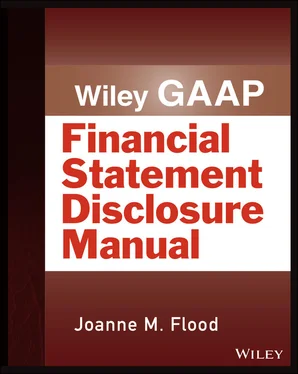1 ...6 7 8 10 11 12 ...38 Methods and significant assumptions used to measure assets and liabilities.
Any subsequent changes to those methods and assumptions.
The type and amount of costs and income accrued in the statement of net assets in liquidation.
The period over which those costs are expected to be paid or income earned.(FASB ASC 205‐30‐50‐2)
The entity should also consider information that would help the reader to better understand the proceedings and where to obtain additional information, including:
Which subsidiaries are included in the filing
The bankruptcy jurisdiction
Key hearings
Agreements reached with creditors
The status of any debtor‐in‐possession and exit financings
It should be noted that disclosures, such as debt covenant violations, required by other Topics may be affected by the filing.
ASC 205‐40, Going Concern
The Codification essentially, with some exceptions, mirrors going‐concern requirements for auditors currently found in PCAOB and AICPA standards. Management must perform, at least annually, an evaluation of the entity's ability to continue as a going concern within one year after the financial statements are issued or, when applicable, available to be issued.
Overall GuidanceManagement must perform two steps:
1 Evaluate, in the aggregate, conditions and events that are known or reasonably knowable at the evaluation date, and
2 Assess whether it is probable that the entity will be able to meet its obligations that are due within one year after the date that the financial statements are issued or available to be issued.(ASC 205‐30‐50‐3 and 50‐4)
The going concern probability threshold is the same used for accounting for contingencies—more likely than not.
Consideration of Management's PlansWhen making going concern assessments, management may consider mitigating plans to determine whether substantial doubt is alleviated. These plans can be considered only if both of the following conditions are met:
It is probable that the plan will be effectively implemented with the year.
It is probable that the plan when implemented will mitigate the conditions or events that raise substantial doubt about going concern.(ASC 205‐ 30‐50‐6 and 50‐7)
In order for these plans to be considered, generally, management or those with authority must approve the plans before the issuance date of the financial statements.
Disclosure Requirements
| Management Conclusion |
Disclosures |
| Conditions do not give rise to substantial doubt. |
No specific disclosures are required. |
| Substantial doubt exists but is alleviated by management's plans. |
In a separate note or part of another note, for example, on debt, information that enables users to assess:Principal conditions or events that raised substantial doubt,Management's evaluation of the significance of those conditions or events in relation to the entity's ability to meet its obligations, andManagement's plans that alleviated those concerns. (ASC 205‐40‐50‐12) |
| After considering all the facts and management's plans, management concludes that substantial doubt remains. |
A separate note with:A statement that there is substantial doubt about the entity's ability to continue as a going concern within one year after the date that the financial statements are issued or available to be issued.Disclosures that allow users to understand:Principal conditions or events that raised substantial doubt,Management's evaluation of the significance of those conditions or events in relation to the entity's ability to meet its obligations. andManagement's plans to mitigate the conditions or events. (ASC 205‐40‐50‐13) |
| In subsequent years |
Present the above disclosures in subsequent financial statements as long as substantial doubt exists. If any changes in conditions or events occur, they should be explained. It is expected that as more is known, the disclosure will become more extensive. If the substantial doubt is resolved in a subsequent period, the entity must disclose how it was resolved. (ASC 205‐40‐50‐14) |
PRESENTATION AND DISCLOSURE EXAMPLES
Example 2.1: Reclassification
During the first quarter of fiscal 20X3, the Company evaluated the impact of the organizational restructuring program (see Note X) on the determination of its operating segments and reporting units. The Company concluded that its operating and reportable segments continue to be Candles, Home Furnishings, and Body Care. However, based on the organizational changes that result from the organizational restructuring and the impact on the information used by the Chief Operating Decision Maker (CODM), the Company reclassified the revenues and costs associated with one brand from the Body Care to the Candles operating segment. The revenues and costs associated with the reclassification of one brand from Body Care to Candles Care have been reflected for the fiscal years ending 20X3 and 20X2. Further, the Company has reclassified amounts presented for depreciation and amortization to reflect the fully allocated amounts included in Operating income (loss) of the segments.
Example 2.2: Income Statement Presentation for Discontinued Operations—Face of the Income Statement
|
20X3 |
20X2 |
| Income from continuing operations before income taxes |
$ 598 |
$ 583 |
| Income taxes |
239 |
233 |
| Income from continuing operations |
359 |
350 |
| Discontinued operations (Note X) |
|
|
| Loss from operations of discontinued component |
1,165 |
1,045 |
| Loss on disposal of discontinued component |
167 |
|
| Income tax benefit |
(532) |
(418) |
| Loss on discontinued operations |
800 |
627 |
| Net income |
$ (441) |
$ (277) |
This example shows the loss on disposal on the face of the income statement. Alternatively, the amount can be shown in the notes to the financial statements, as long as the disclosure identifies the caption in the income statement in which the loss is included.
Example 2.3: Computing the Gain or Loss on Disposal in the Year in Which the Discontinued Operation Is Classified as Held for Sale
Today's Telecommunications has decided to close its pager division, which is a component of the reporting entity. This represents a strategic shift to focus on other divisions of the business. Today's Telecommunications has committed to a plan to sell the assets and liabilities of the division and has properly reclassified the division as held‐for‐sale at that date. The following conditions apply:
The division has incurred $1,750 in losses from operations from the beginning of the year to the date it was reclassified as held‐for‐sale.
The fair value of the assets and liabilities of the division are $10,775.
Brokers’ commissions and other costs to sell are estimated to be $1,650.
The carrying value of the assets and liabilities of the division is $12,525 before the adjustments (depreciation, amortization, adjustment of valuation accounts, and similar periodic adjustments) are made.
The adjustments reduce the carrying value of the assets and liabilities by $125.
Losses from operations of the division from the date it is classified as held‐for‐sale to the end of the fiscal year are $580. (This loss does not include the GAAP adjustments noted above.)
Anticipated future losses from operations of the division from the end of this fiscal year to the expected sales date are $1,999.
Читать дальше












